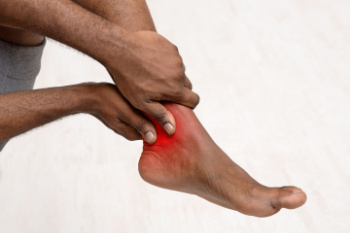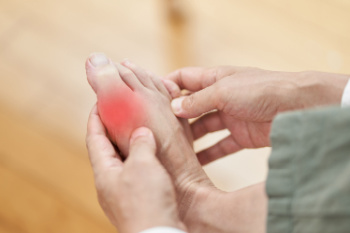
Ankle arthritis can significantly impact daily life, causing pain, stiffness, and swelling surrounding the ankle joint. Symptoms often worsen with activity and can limit mobility. Individuals may notice a reduced range of motion and find it difficult to walk or climb stairs without discomfort. Lifestyle modifications, such as maintaining a healthy weight and choosing appropriate footwear, can help manage symptoms. For more severe cases, surgical interventions like ankle fusion or ankle replacement may be help restore function and reduce pain. Podiatrists can provide a tailored treatment plan to manage symptoms effectively and enhance your overall mobility and comfort. If you are experiencing persistent ankle pain or suspect arthritis, it is suggested you schedule an appointment with a podiatrist.
Ankle pain can be caused by a number of problems and may be potentially serious. If you have ankle pain, consult with Joe Mathew George DPM, FACFAS from Illinois. Our doctor will assess your condition and provide you with quality foot and ankle treatment.
Ankle pain is any condition that causes pain in the ankle. Due to the fact that the ankle consists of tendons, muscles, bones, and ligaments, ankle pain can come from a number of different conditions.
Causes
The most common causes of ankle pain include:
- Types of arthritis (rheumatoid, osteoarthritis, and gout)
- Ankle sprains
- Broken ankles
- Achilles tendinitis
- Achilles tendon rupture
- Stress fractures
- Bursitis
- Tarsal tunnel syndrome
- Plantar fasciitis
Symptoms
Symptoms of ankle injury vary based upon the condition. Pain may include general pain and discomfort, swelling, aching, redness, bruising, burning or stabbing sensations, and/or loss of sensation.
Diagnosis
Due to the wide variety of potential causes of ankle pain, podiatrists will utilize a number of different methods to properly diagnose ankle pain. This can include asking for personal and family medical histories and of any recent injuries. Further diagnosis may include sensation tests, a physical examination, and potentially x-rays or other imaging tests.
Treatment
Just as the range of causes varies widely, so do treatments. Some more common treatments are rest, ice packs, keeping pressure off the foot, orthotics and braces, medication for inflammation and pain, and surgery.
If you have any questions, please feel free to contact our offices located in Joliet, Bolingbrook, and Channahon, IL . We offer the newest diagnostic and treatment technologies for all your foot care needs.

If you think you might be a candidate for bunion surgery, here are key factors to help guide your decision. Bunions are painful bumps on the side of your big toe that develop when the base of the toe pushes outward. Bunion formation is often due to genetics and wearing ill-fitting shoes, particularly high heels. Bunion pain can be managed through various non-surgical treatments such as wearing supportive shoes, and having pain medications or cortisone shots. If these methods fail and the bunion severely impacts your daily life, surgery becomes an option. The type of surgical procedure depends on the severity of the bunion, with moderate cases typically involving shaving the bump and correcting the toe joint's angle. Recovery includes wearing a special boot for a few weeks, and managing bruising and swelling. Delaying surgery can lead to more complex procedures with longer recovery times. A podiatrist will guide you through the recovery process, including follow-up visits to monitor for complications like infections. Keep in mind that surgery may not be a permanent solution, especially if you are genetically predisposed to bunions. Wearing proper shoes and avoiding injuries post-surgery can help maintain the results. If you have a bunion that is causing extreme discomfort, it is suggested that you schedule an appointment with a podiatrist to find out if bunion surgery is right for you.
Foot surgery is sometimes necessary to treat a foot ailment. To learn more, contact Joe Mathew George DPM, FACFAS of Illinois. Our doctor will assist you with all of your foot and ankle needs.
When Is Surgery Necessary?
Foot and ankle surgery is generally reserved for cases in which less invasive, conservative procedures have failed to alleviate the problem. Some of the cases in which surgery may be necessary include:
- Removing foot deformities like bunions and bone spurs
- Severe arthritis that has caused bone issues
- Cosmetic reconstruction
What Types of Surgery Are There?
The type of surgery you receive will depend on the nature of the problem you have. Some of the possible surgeries include:
- Bunionectomy for painful bunions
- Surgical fusion for realignment of bones
- Neuropathy decompression surgery to treat nerve damage
Benefits of Surgery
Although surgery is usually a last resort, it can provide more complete pain relief compared to non-surgical methods and may allow you to finally resume full activity.
Surgical techniques have also become increasingly sophisticated. Techniques like endoscopic surgery allow for smaller incisions and faster recovery times.
If you have any questions please feel free to contact our offices located in Joliet, Bolingbrook, and Channahon, IL . We offer the newest diagnostic and treatment technologies for all your foot and ankle needs.
 Gout and bunions are distinct foot conditions that can sometimes be confused due to similar symptoms of pain and swelling in the big toe area. Gout is a form of inflammatory arthritis caused by the accumulation of uric acid crystals in the joint, leading to sudden, severe pain, redness, and swelling. It often affects the big toe but can occur in other joints. Bunions are structural deformities where the big toe deviates toward the other toes, causing a bony bump on the side of the foot. This can result from wearing tight shoes, genetic factors, or arthritis. Bunions can cause chronic pain, especially while walking or wearing shoes, and can lead to swelling and redness. To manage gout, lifestyle changes such as reducing alcohol and purine-rich foods, staying hydrated, and taking medications to lower uric acid levels are recommended. Bunions may be managed with properly fitting shoes, orthotics, and, in severe cases, surgery. If you have toe pain, it is suggested that you schedule an appointment with a podiatrist for an accurate diagnosis and appropriate treatment plan for either condition.
Gout and bunions are distinct foot conditions that can sometimes be confused due to similar symptoms of pain and swelling in the big toe area. Gout is a form of inflammatory arthritis caused by the accumulation of uric acid crystals in the joint, leading to sudden, severe pain, redness, and swelling. It often affects the big toe but can occur in other joints. Bunions are structural deformities where the big toe deviates toward the other toes, causing a bony bump on the side of the foot. This can result from wearing tight shoes, genetic factors, or arthritis. Bunions can cause chronic pain, especially while walking or wearing shoes, and can lead to swelling and redness. To manage gout, lifestyle changes such as reducing alcohol and purine-rich foods, staying hydrated, and taking medications to lower uric acid levels are recommended. Bunions may be managed with properly fitting shoes, orthotics, and, in severe cases, surgery. If you have toe pain, it is suggested that you schedule an appointment with a podiatrist for an accurate diagnosis and appropriate treatment plan for either condition.
Gout is a foot condition that requires certain treatment and care. If you are seeking treatment, contact Joe Mathew George DPM, FACFAS from Illinois. Our doctor will treat your foot and ankle needs.
What Is Gout?
Gout is a type of arthritis caused by a buildup of uric acid in the bloodstream. It often develops in the foot, especially the big toe area, although it can manifest in other parts of the body as well. Gout can make walking and standing very painful and is especially common in diabetics and the obese.
People typically get gout because of a poor diet. Genetic predisposition is also a factor. The children of parents who have had gout frequently have a chance of developing it themselves.
Gout can easily be identified by redness and inflammation of the big toe and the surrounding areas of the foot. Other symptoms include extreme fatigue, joint pain, and running high fevers. Sometimes corticosteroid drugs can be prescribed to treat gout, but the best way to combat this disease is to get more exercise and eat a better diet.
If you have any questions please feel free to contact our offices located in Joliet, Bolingbrook, and Channahon, IL . We offer the newest diagnostic and treatment technologies for all your foot and ankle needs.

